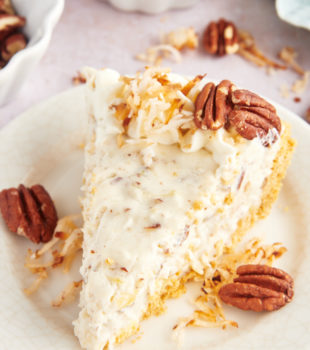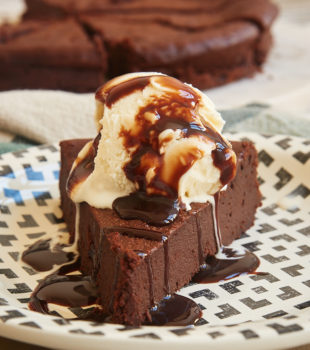Learn 6 simple ways to ripen bananas, whether you’re planning to bake in a few days or today.

How to Ripen Bananas More Quickly
Overripe bananas may not be great for eating out of hand, but they are absolutely perfect for baking. The reason for that is that as bananas ripen, they develop a sweeter taste, and become softer and less starchy. Those are the very things that make them ideal for baking.
If you have a love for banana bread or other banana treats that require ripe or overripe bananas, then you are familiar with the potential struggle of getting those bananas just right and aligned with your baking time.
Getting the bananas to the perfect stage of ripeness can indeed be a bit tricky. It can be challenging to time your baking schedule alongside the ripening progress of your bananas. Luckily, there are some easy tricks for speeding up the ripening process of bananas, whether you’re planning to bake in a couple of days or you’re needing to bake today! Let’s get those unripe bananas in baking shape!
Ripening Bananas Naturally
Bananas continue to ripen after they’re picked. They release a chemical called ethylene, which helps them continue to ripen. You can take advantage of a little chemistry and help your bananas ripen more quickly on their own. Depending on how ripe the bananas were initially, this can take as little as a day or as long as a four or five days.
In a Bunch
Keeping bananas in bunches causes them to ripen more quickly. On the other, hand separating the bananas will slow down the ripening process. If you have banana baking plans coming up on your calendar, be sure to keep them bunched together on your counter so they’ll ripen faster.
Here’s a trick if you use bananas for both eating and baking: You can change the ripening rate of the same bunch of bananas by separating ones you want to eat and leaving the others intact for baking.
On a Banana Stand
You’re likely familiar with banana stands, also known as hooks or trees, that suspend bananas from a hook. They aren’t just a funny way to store your bananas. Those stands allow air to circulate around the bananas to create a more even ripening. The ripening process will take up to a few days, depending on the environment and their initial ripeness.
Other fruit can be stored beneath the bananas to speed things along. Fruits such as apples and pears also release ethylene gas as they ripen, helping bananas ripen more quickly as well.
In Warm Spaces
Heat also speeds up the ripening process for bananas. Simply placing your bananas in a warm spot, such as by a sunny window or above your refrigerator will expedite ripening. This will usually get the bananas into baking form within a day or two, but check on them to monitor their ripening.
You can also place bananas in a recently heated oven that has been turned off but remains slightly warm. Leave the oven light on and check on them frequently through the oven window, and remove them from the oven when black spots begin to appear on the skins. The bananas will continue to ripen at a quicker pace as they cool at room temperature.
Ripening Bananas in a Paper Bag
A simple brown paper bag is a proven trick for helping bananas ripen more quickly by manipulating their environment to make the most of their own ripening abilities.
Place your bananas in a paper bag and close the bag loosely. Leave the bag in a warm, dry spot. As the bananas ripen naturally, the ethylene gas they emit will be contained within the bag and speed the ripening process.
This method can take several hours to a few days, depending on the environment and their beginning ripeness level. Check on them at intervals of several hours until they’ve reached the desired ripeness.
You can also place a ripe, unpeeled apple or tomato in the bag along with the bananas. The ethylene gas from the other fruit also helps ripen the bananas.
Ripening Bananas to Use Today
Remember when we talked about how heat can accelerate the ripening of bananas? Get ready to dial that way up and get those bananas ready to bake today!
In Your Oven
If you just can’t wait to bake some banana bread, then you can really speed things along with your oven. Evenly space unpeeled yellow bananas (not green ones!) on a lined baking sheet. (Parchment paper or aluminum foil will work just fine.) Bake at 300°F for about an hour. Leave the oven light on and check the bananas frequently, as the time needed will vary.
The peels will blacken significantly, but the inside of the bananas will become soft. Cool the bananas at room temperature until they’re cool enough to handle. Then, simply peel and start baking.
Two things to keep in mind: Don’t use this method for ripening bananas to eat, as they’ll be very soft, mushy, and pretty unappealing. Also, don’t use this method for green bananas because they’ve not developed the sweetness of a ripened banana. Green bananas might get softer this way, but they won’t add much flavor to your baking.
In Your Microwave
This method comes with a pretty big asterisk, as it will soften the bananas but not help them gain any of the sweetness you’d expect from normal ripening. The microwave method is generally not nearly as effective as the oven method, but I’m including it here as there may be times it’s useful.
Prick the skins of the bananas in a few spots, making sure to pierce all the way through the skin. Place them on a microwave-safe plate. Heat in the microwave for 30 seconds; then cool them until you can safely handle them. Gently squeeze the banana to test for softness. If necessary, heat for another 30 seconds and repeat testing until they’re appropriately soft. Cool the bananas at room temperature. Then, peel and use for your recipe.
This process will usually take 30 to 90 seconds. With varying levels of beginning ripeness and differences in microwaves, your bananas may require more or less time.
How to Store Overripe Bananas
If you find yourself with perfectly overripe bananas but no time to bake, then the freezer is your new best friend. Simply place the peeled or unpeeled bananas in a freezer bag and store in your freezer for up to two months. They may be fine after that period of time, but they’ll be at their best within two months.
Whether you freeze them peeled or unpeeled is a matter of preference. The peels will turn very dark and soft in the freezer. They can be difficult to remove, so you may find it simpler to peel them before freezing. Some say that bananas will store longer without the peels, too.
If you want to freeze your bananas without the peels, you may find it beneficial to freeze them in a single layer on a rimmed baking sheet first. After they’re frozen solid (likely after a couple of hours), then they can be placed together in a freezer-safe bag. That will make them easier to remove individually later.
When you’re ready to bake, thaw the bananas overnight in the refrigerator, give them a mash, and start baking!











2 Comments on “How to Ripen Bananas”
I really was impressed with the information about ripening bananas. I really want to make the hummingbird bundt cake tuesday. I bought some very ripe bananas but I don’t think they will be quite ready. I think I’ll use the oven way. No brown bags here.
Thanks for the tips.
Happy to help, Maureen! Enjoy the cake!